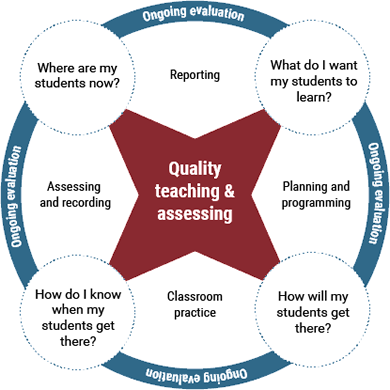
Curriculum planning and programming aims to:
-
be responsive to student needs, interests and abilities
-
provide a seamless progression of learning within and across school years
-
focus on learning of high intellectual quality and significance
-
make explicit high expectations for learning and achievement
-
enhance professional practice through collaborative development and evaluation.
These aims are described in the Programming for quality teaching and assessing course.
The diagram on the right locates planning in the teaching and learning cycle. Text version (.docx 167kB).
A detailed knowledge of the syllabus underpins the curriculum planning process. Planning also necessarily reflects your wider school context.

School context can be analysed according to:
-
students’ needs
-
school identified priorities
-
pedagogical considerations
-
teacher and student interests
-
teacher expertise
-
local context and fieldwork opportunities.
|
|
Identify or discuss the factors in your school context which may impact on developing a curriculum plan for geography. Hold these thoughts in mind as you move onto the next tab. |
Best practice for teaching geography
The Geography K–10 Syllabus teaches geographical thinking through the geographical inquiry process.
The questions posed in geographical inquiries ask geographical questions. These questions lead students to think about the geographical issues entailed in the case study.
The approach recommended in this course is to undertake geographical inquiries through contemporary case studies relevant to students. Geographical tools are used at each step of the inquiry process.
.png)
This diagram is based on a model developed by Stuart Delandre, principal Illawarra EEC.
Many schools and teachers (particularly in K–6) are adept at creating units of work that intertwine learning from several key learning areas.
Science, history and geography, however, are increasingly recognised as having their own discipline base and inquiry approach. Blurring these distinctions is unhelpful when teaching students to think appropriately for the type of inquiry they are undertaking.
Recommendation 1: Frame geographical inquiries entirely within a geography focus.
Geographical inquiries can be connected to historical inquiries and/or scientific investigations. Nevertheless, it is recommended that each inquiry remains distinct and dedicated to the particular subject discipline it represents.
|
|
Read the Inquiry learning in the HSIE KLA (.docx 237kB) discussion paper, which explores the discipline-based skillset involved in geographical inquiry. |
The introduction of the Geography K–10 Syllabus completes the replacement of the HSIE K–6 syllabus. This process began with the arrival of the History K–10 Syllabus.
Recommendation 2: Start with the Geography K–10 Syllabus and create units of learning based around the geographical inquiry process, rather than reworking and adapting existing units.
|
|
Activity 1: School context With reference to the teaching and learning cycle in the previous tab and the two recommendations in this tab, what factors in your school context may impact the implementation of the Geography K–10 Syllabus? Record your responses in the Activity booklet. |

© A Southwell
A scope and sequence maps what syllabus content will be taught and when this is to happen.
It contains syllabus outcomes and content organised for each stage that are balanced and time-effective. Scope and sequence documents also reflect the context of your school.
Developing a scope and sequence
Teaching teams will need to consider both a collaborative process for developing a scope and sequence and the amount of detail and format used. The remainder of this course seeks to assist teachers to:
-
explore the syllabus material for one stage
-
create an implementation plan for one focus area of the NSW Geography K–10 Syllabus.
The course deliverable will provide a starting point for creating a rigorous geography scope and sequence for your school.
Schools need to regularly revise and cross reference their scope and sequence to the syllabus requirements to ensure that changes in school context, assessment schedules, resources and staff expertise are reflected positively in school planning.
|
|
Identify and discuss the current state of your school’s scope and sequence for geography. |



